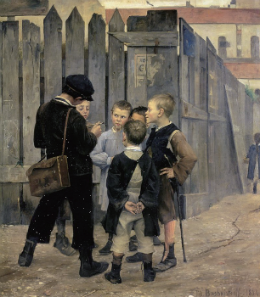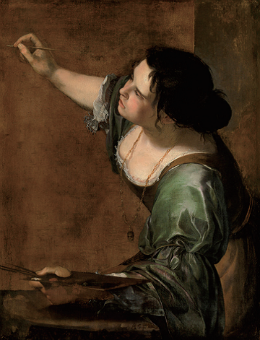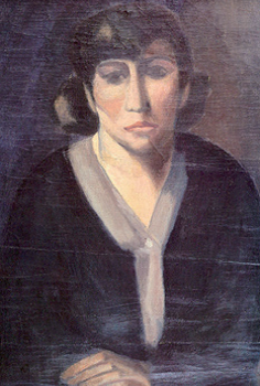In the past, women painters were confronted with various restrictions in their activities because women had a lower social status than men. While most women conformed to social customs and gave up on their dreams, there were some painters who firmly stood against the stereotypes toward females. These artists actively produced many artworks and became recognized for their talents. Furthermore, they are still exerting substantial influence on the current art world as feminist artists. The Sungkyun Times (SKT) now introduces two representative feminist artists Artemisia Gentileschi and Na Hye-seok and their works of art.
An Example of Unfair Treatment Toward Women Painters
A few months ago, there was an exhibition called “The Musee d’Orsay Exhibition” at Seoul Arts Center’s Hangaram Museum. The exhibition displayed many masterpieces at the Musee d’Orsay, which is located in Paris, France. Among the 131 works of art, there was “A Meeting,” which was painted by the Ukrainian painter Marie Bashkirtseff in 1884. At the time, the art piece received a lot of favorable comments from the public and media. Many people expected that it would win a prize at the 1884 Salon. The result, however, did not go in her favor because she was a woman, which made her extremely disappointed. Tragically, in the same year, she died at the age of 25 due to tuberculosis. According to Google Arts & Culture, she wrote in her diary “I am exceedingly indignant because, after all, works that are really rather poor have received prizes.” and “There is nothing more to be done. I am a worthless creature, humiliated, finished.” Like this, her goal of being acclaimed as a great painter was frustrated simply because she was a woman.

Artemisia Gentileschi, Woman with the Soul of Caesar
Like the example of Marie Bashkirtseff, there are numerous examples of women artists who were treated unequally in the past, but some women painters did struggle to fight against these harsh circumstances and eventually left their names in the history books. Artemisia Gentileschi (1593 - 1653) is one of these painters. Artemisia Gentileschi was an Italian painter during the Baroque Period, the era from 1600 to 1750 when new artistic styles emerged. Moreover, she was the first woman artist to become a member of the Accademia delle Arti del Disegno, an academy of artists in Florence, Italy.
Gentileschi and Feminism

“I will show what women can do.
You will find the spirit of Caesar in the soul of a woman.”
According to the Merriam-Webster dictionary, feminism is the theory of the political, economic, and social equality of the sexes. When Gentileschi was a teenager, she was sexually assaulted numerous times by her art teacher, who happened to be her father’s friend Tassi. She accused him, but many people considered her to be an immoral woman. Despite this hardship, she did not give up her dream of becoming a painter who drew pictures that broke the stereotypes about women. The women in her works of art were mostly very cruel, brutal, and overweight. Furthermore, Gentileschi became the first woman painter to draw historical and religious pictures. In fact, such genres were considered to be beyond women’s capacity back then.
Her Representative Work of Art
<Judith Slaying Holofernes>

This painting , which was drawn between 1614 and 1620, illustrates a popular story in the Old Testament of a Jewish widow named “Judith” saving the nation from Assyrian soldiers . In the picture , she is severing the head of Holofernes, the Assyrian general, after luring him and getting him drunk. This is a common story that many other artists drew before and Judith was usually expressed as an erotic and charming woman. Artemisia, however, depicted Judith as a strong woman with broad shoulders and menacing forearms. She drew her own face on Judith and Tassi on Holofernes, and Judith seems to slay Holofernes without any hesitancy.
Na Hye-seok, Modern Woman of Korea
Na Hye-seok (1896 - 1948) was the first female Western-style painter in Korea during Japanese Colonial Rule (1910 - 1945). She studied Western oil paintings at Tokyo Arts College as an international student, which in itself became a hot issue because there were not many female students who studied abroad at that time. After graduation, Na returned to Korea and started her career as an artist.
Na Hye-seok and Feminism

“Women are also humans.”
In the past, women could not get the same education as men in Korea. Na, however, claimed that women have the right to receive education and should be treated equally. Through her life, she showed how progressive and confident a woman could be. While a majority of male artists fell into despair by the reality that Korean society did not appreciate oil painting, a new style of art, she did not care about others’ judgments and kept drawing. Consequently, she became the first painter to establish oil painting during the Joseon Dynasty and the first woman to hold private exhibitions of oil paintings in Korea. Moreover, when Kim Woo-young, a lawyer Na met in Japan, and asked for her hand in marriage, she presented some unconventional marriage conditions such as “Do not prevent me from painting” and “Do not force me to take care of parents-in-law and children.” She put these marriage terms in newspaper advertisements, which caused widespread repercussions in the whole country.
Her Representative Work of Art
<Self Portrait>

The self portrait of Na Hye-seok is unique in that it does not resemble her. Na drew herself with an androgynous and exotic appearance. Unlike her personality of enterprise and confidence, the woman in the painting has a long face and the background is very dark. Some say that Na purposely portrayed major differences between her real face and the picture in order to express her uncomfortable feeling toward the patriarchal society.
It is very difficult to eliminate the stereotypes and conventions that are rampant in a society and the whole world. Therefore, the people who strongly oppose negative conventions and eventually cause positive impacts on society are those with exceptional courage. In the art world, Artemisia Gentileschi and Na Hye-seok are two women painters who showed their courage, inspiring women and even contemporary society. The SKT hopes that Kingos also have the courage to have positive influences on the circumstances around them.
